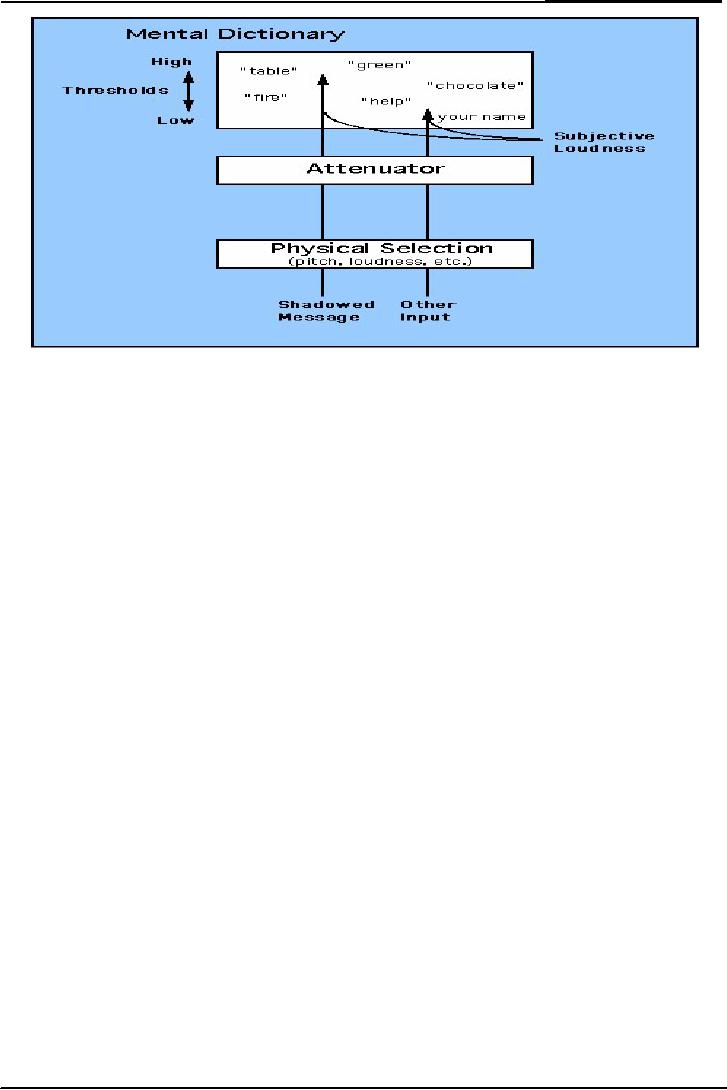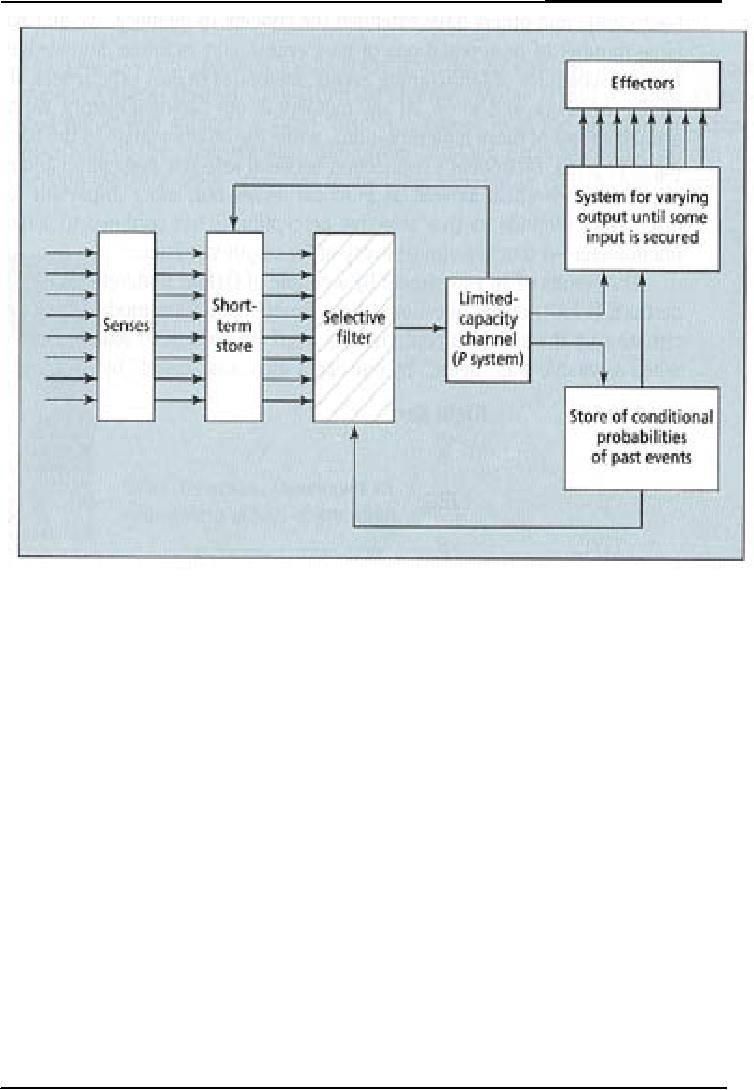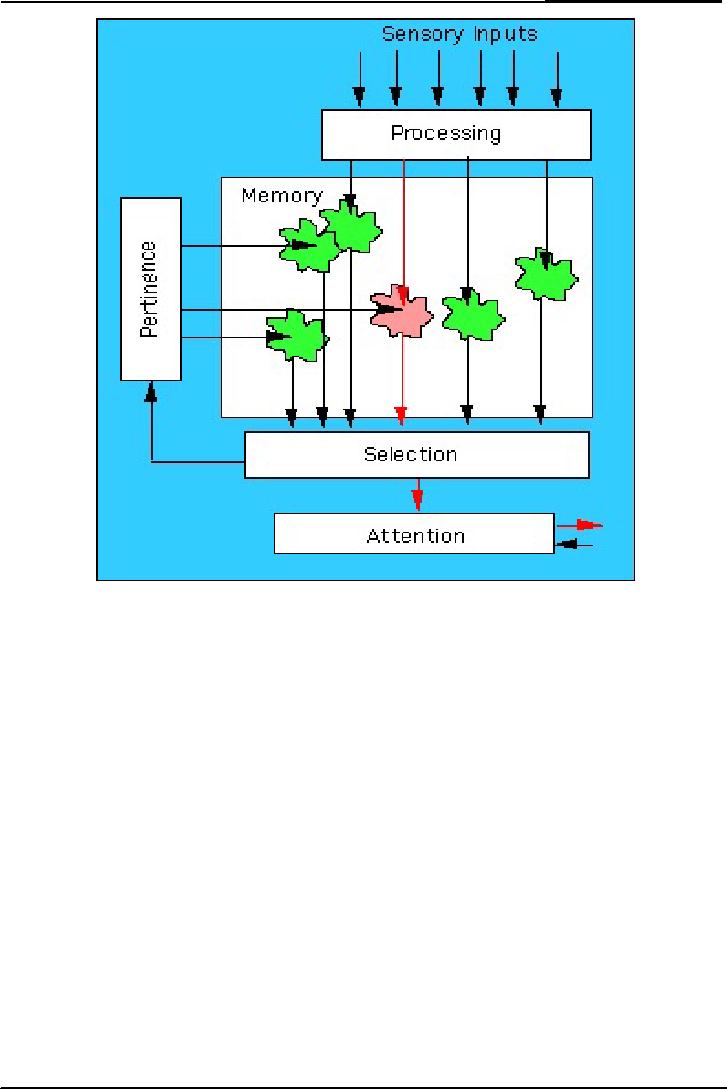 |

Cognitive
Psychology PSY 504
VU
Lesson
08
ATTENTION
(continued)
Attention
and meaning
Two
undergraduates at Oxford, Gray
and Wedderburn (1960),
conducted an experiment.
They
said
if attention is low level
process and select early,
then the meaning should
not be important.
And
they demonstrated that
subjects were quite
successful in following a message
that jumped
back
and forth between ears.
Shadow meaningful messages
that were given to the
subjects
were:
�
Left
Ear: John Eleven
books
�
Right
Ear: Eight writes
Twenty
Instructed
to shadow the meaningful
message, subjects reported:
John writes books.
Thus,
subjects
are capable of shadowing a
message on the basis of
meaning rather than physical
ear.
Implications
In
this experiment subjects
switched some information
and select meaningful words
whether they
were
presented in left ear or
right ear.
So
this experiment proved
attention can use meaning
that is a higher level
process. Attention is
probably
not an early selector but a
late selector.
Triesman's
experiment
Treisman
(1960) conducted an experiment to
know are the attention is
early selector or
late
selector.
In this experiment subjects
are asked to shadow message
in Left ear. The
messages
are:
�
In
Left area: I was going
there when/ China, smoke,
lovely, chirping
�
In
Right Ear: books, chairs,
tables, elephant/ I saw a
bright flash
Many
subjects switched ears to
follow the meaningful
message.
Attention
models
1.
Treisman's Model
Trisemen
gave early selection model
according to his experiment. In
this model at bottom
there
are
shadow message that is to
which attending and other
message is other input. She
said there
is
not filter there is
attenuator. Attenuator weakened
unattended signals. After
attenuator
information
is processed in mental dictionary
where some things are
very important than
other.
Like
our name is important rather
than table or fire. This
model explains selection on
the basis of
meaningful
information. This all is
showing in this
figure..
22

Cognitive
Psychology PSY 504
VU
2.
Broadbent's experiment
He
was working on how skill
created. And information processing
his model shows senses
take
information
within their limited
capacity. Then this
information goes in short-term
store. Short term
store
is limit less because all
the information is retained
that receives by senses but
only for a
very
brief period. This short
term store is sensory store.
Then the selective filter
tune out extra
information
and pass selected
information. Then limited
capacity channel pass the
important
information
to other channels. One is
going back toward short
term store that is feedback
loop.
Limited-capacity
channel pass information to
the store of conditional
probabilities of past
events.
This
also moves again towards
selective filter. Then
information is going to system
for varying
output
until some input is secured
channel. And then depending on
what is happening we
move
towards
effectors. It means our
physical response towards
attention. The most
important thing in
Broadbent's
model is selective filter is
soon after short term
store. This models does
not select on
the
basis of meanings.
Broadbent's
Model
23

Cognitive
Psychology PSY 504
VU
3.
Norman's Model
Another
model is given by Norman.
This model is not very
popular. Norman tried to
explain
attention
is late selector. He said we
get all information that
store in short term memory
than in
long
term memory. In long term
memory we check its
relevance when relevance is
done we
select
information and then pay
attention. This is opposite
model.
24

Cognitive
Psychology PSY 504
VU
There
are two most important
models:
1.
Early selection model
2.
Late selection model
Early
selection model also are of
two types one uses
filter that is given by
Broadbent and other
model
uses attenuator that is
given by Triesman. Filter
model means filter some
things are pass
and
some are stopped. Attenuator
means some information is
weakened and some
strengthens.
In
Mental dictionary some
things are very important
for us. These things
are strengthens bye
attenuator.
25
Table of Contents:
- INTRODUCTION:Historical Background
- THE INFORMATION PROCESSING APPROACH
- COGNITIVE NEUROPSYCHOLOGY:Brains of Dead People, The Neuron
- COGNITIVE NEUROPSYCHOLOGY (CONTINUED):The Eye, The visual pathway
- COGNITIVE PSYCHOLOGY (CONTINUED):Hubel & Wiesel, Sensory Memory
- VISUAL SENSORY MEMORY EXPERIMENTS (CONTINUED):Psychological Time
- ATTENTION:Single-mindedness, In Shadowing Paradigm, Attention and meaning
- ATTENTION (continued):Implications, Treisman’s Model, Norman’s Model
- ATTENTION (continued):Capacity Models, Arousal, Multimode Theory
- ATTENTION:Subsidiary Task, Capacity Theory, Reaction Time & Accuracy, Implications
- RECAP OF LAST LESSONS:AUTOMATICITY, Automatic Processing
- AUTOMATICITY (continued):Experiment, Implications, Task interference
- AUTOMATICITY (continued):Predicting flight performance, Thought suppression
- PATTERN RECOGNITION:Template Matching Models, Human flexibility
- PATTERN RECOGNITION:Implications, Phonemes, Voicing, Place of articulation
- PATTERN RECOGNITION (continued):Adaptation paradigm
- PATTERN RECOGNITION (continued):Gestalt Theory of Perception
- PATTERN RECOGNITION (continued):Queen Elizabeth’s vase, Palmer (1977)
- OBJECT PERCEPTION (continued):Segmentation, Recognition of object
- ATTENTION & PATTERN RECOGNITION:Word Superiority Effect
- PATTERN RECOGNITION (CONTINUED):Neural Networks, Patterns of connections
- PATTERN RECOGNITION (CONTINUED):Effects of Sentence Context
- MEMORY:Short Term Working Memory, Atkinson & Shiffrin Model
- MEMORY:Rate of forgetting, Size of memory set
- Memory:Activation in a network, Magic number 7, Chunking
- Memory:Chunking, Individual differences in chunking
- MEMORY:THE NATURE OF FORGETTING, Release from PI, Central Executive
- Memory:Atkinson & Shiffrin Model, Long Term Memory, Different kinds of LTM
- Memory:Spread of Activation, Associative Priming, Implications, More Priming
- Memory:Interference, The Critical Assumption, Limited capacity
- Memory:Interference, Historical Memories, Recall versus Recognition
- Memory:Are forgotten memories lost forever?
- Memory:Recognition of lost memories, Representation of knowledge
- Memory:Benefits of Categorization, Levels of Categories
- Memory:Prototype, Rosch and Colleagues, Experiments of Stephen Read
- Memory:Schema Theory, A European Solution, Generalization hierarchies
- Memory:Superset Schemas, Part hierarchy, Slots Have More Schemas
- MEMORY:Representation of knowledge (continued), Memory for stories
- Memory:Representation of knowledge, PQ4R Method, Elaboration
- Memory:Study Methods, Analyze Story Structure, Use Multiple Modalities
- Memory:Mental Imagery, More evidence, Kosslyn yet again, Image Comparison
- Mental Imagery:Eidetic Imagery, Eidetic Psychotherapy, Hot and cold imagery
- Language and thought:Productivity & Regularity, Linguistic Intuition
- Cognitive development:Assimilation, Accommodation, Stage Theory
- Cognitive Development:Gender Identity, Learning Mathematics, Sensory Memory